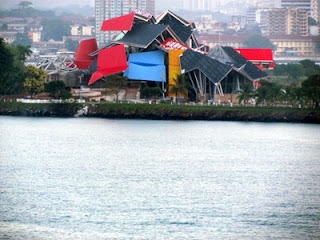Even though I knew the basic story of the building of this great structure, I never realized what it really took to do it. McCullough makes the story of this epic human endeavor come alive!
Just experiencing a part of it through Lake Limon on the Atlantic side isn’t enough. You have to do it all—like go through the Culebra Cut (known as “The Ditch”), the nine mile stretch which was the main engineering challenge of the 40 years of construction effort by the French and the Americans. And, there is so much more. If you are really interested, read McCullough or watch the PBS video by clicking on the arrow on the photo below.
Some little known financial facts: it cost Holland America $35,000 just to make a RESERVATION to go through the canal today. The toll for the today’s 50 mile transit for our ship is $250,000. The lowest toll ever charged was 36 cents, paid by Richard Halliburton when he swam through the canal in 1928.
Here are the highlights of my cruise through the Panama Canal.
We started just as the sun was rising.
We pass under the Bridge of Americas which is the highway that connects Panama with Central America.
We soon see the construction of the Canal Expansion which will double the PC’s capacity to handle the increasing demand for world-wide trade and larger ships.
A close-up of the cement work on the locks look very similar to the way the old ones were constructed.
We soon arrive at the Miraflores locks. These are double locks, so you go through two chambers to lift the ship 54 feet. Container ship in the left lane is a high point in first chamber.
These gates on the Pacific are the heaviest and largest to accommodate the higher Pacific tides. Each gate weighs 745 tons and is 82 feet high.
Here is what they looked like when under construction. They are hollow so they can float.
Workers are putting the plates on. The size of the men compared to the gates give you some perspective of their size.
The process of going through the locks is interesting. Men in row boats attach cables from the “mules” to the ship. The mules are named for “old Sal" of Erie Canal fame.
The mules run along a cog-wheel track next to the ship. They don’t drag the ship; they just keep it aligned as it goes through the chambers.
About a mile after the Miraflores Locks is the Pedro Miguel lock. It is a single lock which raises the ship another 31 feet. Soon afterward, you pass under the Centennial Bridge which part of the Highway from Alaska.
Around that curve in the canal is the famous Calebra Cut.
It doesn’t look too spectacular until you realize that this passage was a “ditch” cut through the Continental Divide…solid rock, millions of tons of the stuff had to be blasted and cut away. It is said that the amount of stuff excavated would be equivalent to a 12 foot square hole cut through the center of the earth.
Compounding the problem was mud slides. Even though they terraced the cut, the tropical downpours would cause the mud to fill-up the work they had done and derail trains they were using to carry the debris away. Here’s a photo of one such event:
The Canal continues into Gatun Lake which is the largest man-made lake in the world. The Chagris River had been dammed to fill its valley to the planned 85 feet. It covers an area the size of Barbados and was built so the ships could go from the Pedro Miguel Lock to the Gatun locks where they are then lowered back to sea level on the Atlantic.
It takes eight hours to cross the Canal. It was a wonderful way to end 2012.

















AMAZING! Just amazing!
ReplyDelete